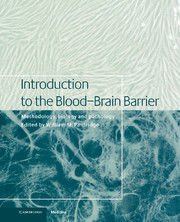Book contents
- Frontmatter
- Contents
- List of contributors
- 1 Blood–brain barrier methodology and biology
- Part I Methodology
- Part II Transport biology
- Part III General aspects of CNS transport
- Part IV Signal transduction/biochemical aspects
- Part V Pathophysiology in disease states
- 41 Cerebral amyloid angiopathy
- 42 Brain microvasculature in multiple sclerosis
- 43 Hemostasis and the blood–brain barrier
- 44 Microvascular pathology in cerebrovascular ischemia
- 45 HIV infection and the blood–brain barrier
- 46 Hypertension
- 47 The blood-brain barrier in brain tumours
- 48 The pathophysiology of blood–brain barrier dysfunction due to traumatic brain injury
- 49 Cerebral malaria and the brain microvasculature
- 50 Molecular basis of tissue tropism of bacterial meningitis
- Index
47 - The blood-brain barrier in brain tumours
from Part V - Pathophysiology in disease states
Published online by Cambridge University Press: 10 December 2009
- Frontmatter
- Contents
- List of contributors
- 1 Blood–brain barrier methodology and biology
- Part I Methodology
- Part II Transport biology
- Part III General aspects of CNS transport
- Part IV Signal transduction/biochemical aspects
- Part V Pathophysiology in disease states
- 41 Cerebral amyloid angiopathy
- 42 Brain microvasculature in multiple sclerosis
- 43 Hemostasis and the blood–brain barrier
- 44 Microvascular pathology in cerebrovascular ischemia
- 45 HIV infection and the blood–brain barrier
- 46 Hypertension
- 47 The blood-brain barrier in brain tumours
- 48 The pathophysiology of blood–brain barrier dysfunction due to traumatic brain injury
- 49 Cerebral malaria and the brain microvasculature
- 50 Molecular basis of tissue tropism of bacterial meningitis
- Index
Summary
Introduction
Tumors are vascularized by sprouting of capillaries from pre-existing vessels in a process termed angiogenesis (reviewed by Plate and Risau, 1995). The new vessels constitute the tumor vascular bed, or blood-tumor barrier, which, in most cases, is highly abnormal in terms of its angioarchitecture, barrier properties and ultrastructure. The angioarchitecture within most tumors consists of largediameter, tortuous vessels that are irregularly spaced, leaving variably sized avascular regions (Baish et al., 1996). As a result there are regions of flow-limited transport and the blood flow through the tumor as a whole is reduced, despite the lower resistance that would be expected from the increase in vessel diameter.
Barrier loss in tumors
In all brain tumors, with the exception of lowgrade gliomas (Fig. 47.1), the vessels are more permeable than normal brain capillaries (reviewed by Stewart, 1994). Loss of barrier properties has some advantages in that it allows imaging of the tumor using contrast-enhancing agents that do not cross the intact barrier (Fig. 47.1) and it also permits delivery of hydrophilic drugs to the tumor. However, barrier loss also gives rise to cerebral edema, which is a significant cause of morbidity and mortality in the patient. Furthermore, the increased tissue pressure created by the edema, and the mass effect of the tumor within the closed cranium, further limit blood flow to the tumor and surrounding brain.
- Type
- Chapter
- Information
- Introduction to the Blood-Brain BarrierMethodology, Biology and Pathology, pp. 434 - 440Publisher: Cambridge University PressPrint publication year: 1998
- 2
- Cited by



